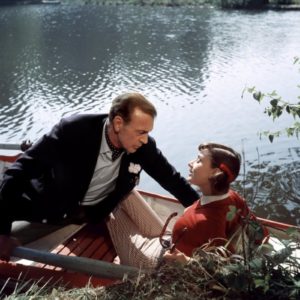Wilder added the picnic to Love in the Afternoon as a setting for comic action and romantic courtship. His sources for the film Paul Anet’s Ariene, juene file Russe (1920), and Paul Czinner’s film adaption The Loves of Ariene (1931) do not have picnics.
The picnic between Ariene Chavasse and Frank Flanagan is a contest between youth and middle age. Ariene has the advantage as long as she is coy. This tactic keeps Flannagan, an experienced womanizer, thirty years her senior, off-base. 
Wilder’s folding picnic table is chockablock with food enough for himself and the cast and crew: two roast chickens (there are four legs), two French baguettes, a bowl of tomatoes, a bowl of seasonal fruits, a thermos and coffee pot, and a bucket of iced champagne. (All arrived in Flannagan’s Rolls Royce and serviced by staff.)
The best moment happens when Flannagan and Ariene duel over a chicken leg.
Ariene: Would you pass me the salt, please?
Frank: Put that chicken leg away.
Frank: Ariene: I’m hungry.
Put it away!
Ariene: Yes, Mr. Flannagan. Any particular place?
Frank: Put it away!
Ariene: All right, Mr. Flannagan
And with that, she puts the chicken leg in Frank’s shirt pocket.
The cast: Gary Cooper as Frank Flannagan; Audrey Hepburn as Ariene Chavasse
See Billy Wilder. Love in the Afternoon (1952). The screenplay by Billy Wilder and I. A. L. Diamond is based on Claude Anet’s Ariene, juene file Russe (1920).
*Two years later, Alfred Hitchcock’s added a chicken leg picnic in To Catch a Thief (1955). Erich Rohmer’s somber Love in the Afternoon (L’Amour après-midi) 1972 is unrelated to Wilder’s comedy.

